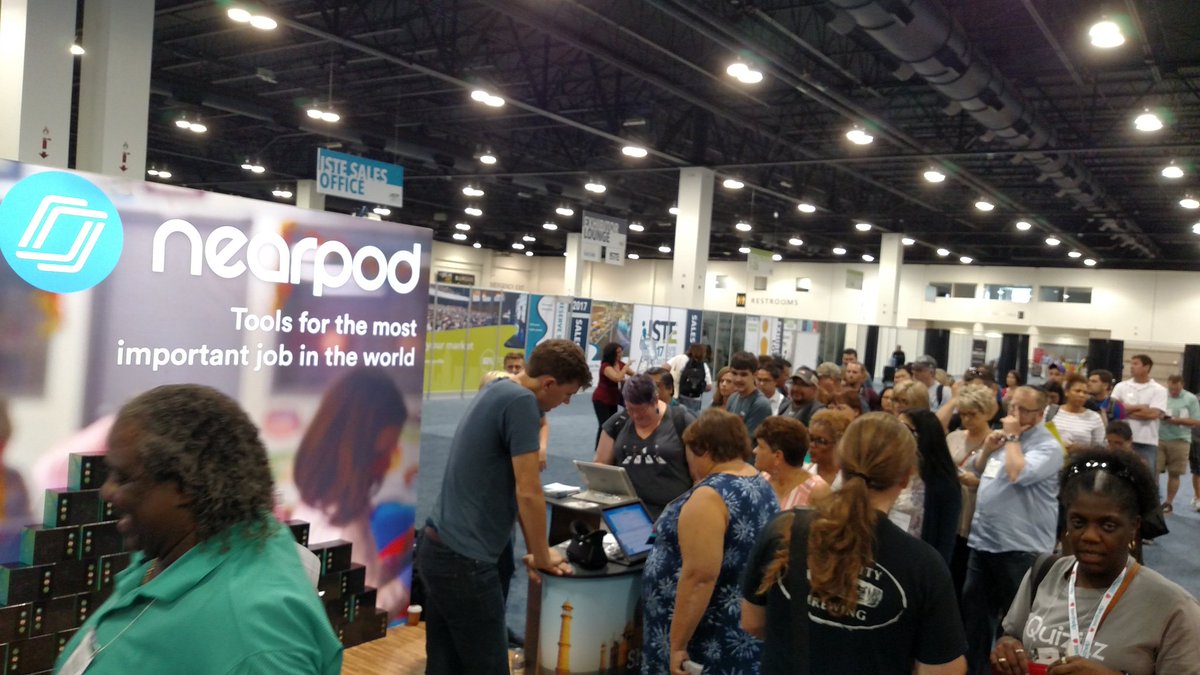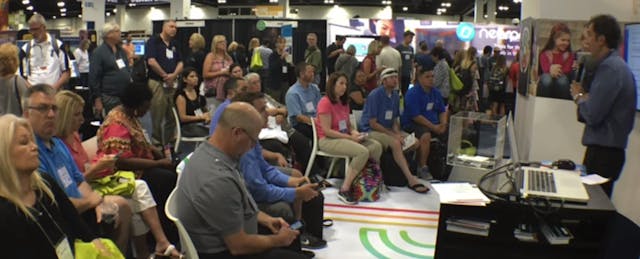The ISTE conference isn’t the biggest edtech conference in the world by sheer luck. It brings together K-12 educators, companies, reporters, university professors, and students to talk about product announcements, implementation strategies and edtech trends.
This year’s gathering, spread over several hotels and the Denver Convention Center, drew over 15,000 almost 20,000 people into to these conversations. We caught a few tidbits—take a look below.
THE BIG GUYS: Here’s news from Google, ABCMouse, and Amazon. First up, Google Education announced a new “casting” app for the classroom projector, released the “Expeditions” virtual reality app for all teachers and students, and added a new quizzing feature in Google Forms. (Full EdSurge coverage on Google here.) Wondering about Apple? The company didn’t announce anything in tandem with ISTE, but did push the Swift coding app—Swift Playgrounds—for middle and high school students that got announced two weeks ago.
ABCMouse, who’s grouped in with the “big guys” because of its record-making $150M fundraising round, released its flagship K-12 product, ABCMouse for Schools. David Samuelson, Age of Learning's head of global schools, told EdSurge in an interview that the product (currently geared at Pre-K, kindergarten and first grade) is essentially the ABCMouse consumer product—a collection of multi-subject learning activities—with all the necessary K-12 add-ons, like curriculum and professional development. “It’s rare that you have the ability to to take consumer technology and offer it to schools,” he said.
And then, there’s Amazon. Back in February, an EdWeek brief reported that Amazon Education was beta-testing a new platform with educators, helping teachers navigate the jungles of open educational resources (OER). That platform—Amazon Inspire—has officially launched in tandem with ISTE conference, offering a way for educators to both upload and access resources like lesson plans, videos and games.
CONFUSION AROUND “OPEN”: While Amazon references its platform as “open,” a few questions arose during ISTE as to what it actually means to have a fully-open ecosystem. According to Amazon’s General Manager of K-12 Education Rohit Argawal, districts can restrict who sees their educators’ uploads on Inspire—meaning certain resources will be limited to limited school or district communities. Similarly, McGraw-Hill President of K-12 Christine Willig reports that her company has partnered with Knovation on creating an open resource platform, but it will only be available to current McGraw-Hill users or paying customers. As such, whether these platforms can refer to themselves as 100% open is up for debate. (See two sides of the argument here and here.)
WHAT ARE TEACHERS EXCITED ABOUT? Digital citizenship, making and virtual reality all had strong showings at ISTE 2016, observable by the throngs of educators lined up to learn, including this line shown below at the Nearpod booth in the ISTE Expo Hall. (Though, that might’ve been because of the free VR headset giveaway.)

@GuidoNearpod @josh_nearpod #ISTE2016 is going bananas for a chance at the @Nearpod VR kit. Love it! pic.twitter.com/4ZIax3aDBA
— Matty Fox (@what2foxsay) June 28, 2016
MAKING THE PRIVACY CUT: A 2013 Fordham study found that less than 7 percent of the district-vendor contracts restricted the sale of student information by vendors. A bit scary, right? It’s important to know which vendors are handling privacy policies well and which aren’t. To help out schools, nonprofit Common Sense Media announced at ISTE that it has published a new set of product reviews featuring the good, the bad and the negligent when it comes to privacy. One of the top performers? ClassDojo.
WELCOME TO THE FAMILY: IXL has released science and social studies content for grades two through five onto its adaptive learning platform, adding to a suite of subjects that also includes math and English language arts. The science curriculum will make use of interactive activities and diagrams to explain concepts from the natural sciences, physics and chemistry, among others, while the social studies curriculum asks students to engage with primary sources.
MICROSOFT LOVES ITS PARTNERS: Microsoft has partnered with edX on five upcoming courses for school principals, headmasters, superintendents and other leaders. Rolling out in fall of 2016 and into 2017, the courses will cover as yet undetermined aspects of school leadership. Additionally, Microsoft also announced a partnership with ISTE on the "Blueprint for School Transformation" (a framework that maps ISTE's "Essential Conditions" to Microsoft's "Transformation Framework" for school rollouts and conversions to digital). Microsoft and ISTE also plan to work with school in the Microsoft Showcase Schools program to integrate ISTE's standards of edtech integration.
THE INTERNET WILL BE EVERYWHERE AND NOWHERE: One person who Microsoft might not partner with any time soon is physicist Dr. Michio Kaku, the opening keynote who jokingly referred to “Microsoft Works” as an oxymoron. Kidding aside, Kaku showed educators the forest that he and others believe will encircle the classroom of the future—one that includes more machine learning, tech-rich contact lenses, and robo-doctors.


